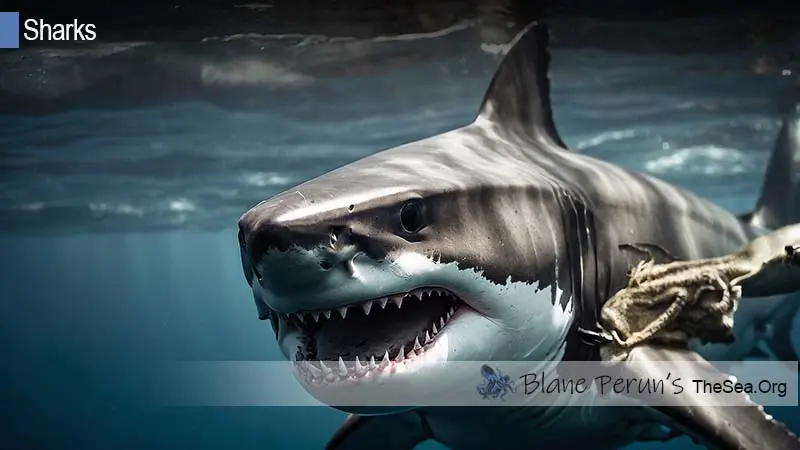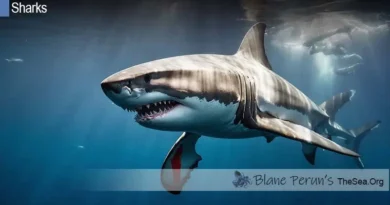Great White Shark Predators
In the hunt for great white shark predators, scientists have tagged numerous individuals and gathered significant data from specimens that have been attacked and/or eaten. The results show great whites are seldom attacked, as they are usually the attackers due to their superior anatomy, sharper teeth and greater strength. Even whale sharks – the largest documented sharks in the ocean – don’t attack great whites. The greatest adversaries of the white pointers are the orca (the killer whale) and… the great white itself!
Not many animals exist that can be classified as predators to great white sharks. Even though the great white isn’t the largest fish in the sea, it is classified as having no natural predators. Great whites are not only the rulers of the ocean, but also some of the most dangerous fish out there, with fine-tuned senses a keen predator instinct and the ability to reach speeds of over 24 km/h. Documented accounts exist, however, of marine animals that are capable of attacking, defeating and eating a great white shark.
When scientists played killer whale sounds to great white specimens, the sharks were visibly distressed. This was already a clear sign that the orca is one of the species that could be categorized as great white shark predators. According to data obtained from observations and actual footage of orca attacks, the superior intelligence and strength of the orca plays a key role in the great white’s defeat. The whales have been found to attack them near the Farallon Islands off the coast of California. The hunting technique involves the orca flipping the shark on its back and keeping it in that position for a full 15 minutes, which causes it to suffocate due to a specific weakness in its anatomy known as tonic immobility. Orcas don’t normally choose to attack great white sharks, however, due to different dietary preferences.
It’s a well-known fact that great white sharks eat almost anything. This means they also eat each other and, according to scientists, this fact has actually been documented. Smaller great whites were observed to clear the water when a larger specimen showed up, and it’s not uncommon for the larger shark to attack them. In one instance, a 9-ft. long specimen was found to have been eaten by a mysterious larger adversary. It turned out that the culprit was one of the most feared great white shark predators – a member of the same species that has grown to a giant size.
The Comprehensive Guide to Understanding the Predators of Great White Sharks
Great white sharks, often labeled as the ocean’s top predator, are awe-inspiring creatures. However, like every animal in the vast marine ecosystem, even they face threats. While it may be difficult to imagine, certain animals do prey on great white sharks. In this detailed guide, we’ll delve deep into understanding the natural adversaries of these magnificent creatures. Among these predators are orcas, which have been known to hunt great white sharks in Florida, particularly for their nutrient-rich livers. Additionally, young great whites may fall victim to larger shark species or even their own kind in competition for food. Understanding these dynamics is crucial for conservation efforts aimed at protecting great white sharks and maintaining the balance of marine ecosystems.
The Life Cycle of Great White Sharks
Understanding the life cycle of the great white shark is essential to grasp when and why they are vulnerable. By studying the various stages of their life cycle, from birth to adulthood, researchers can identify critical periods when these apex predators are most at risk. Additionally, incorporating knowledge of great white shark behaviors and habits provides insight into their feeding, breeding, and migratory patterns, which are crucial for conservation efforts. Understanding these factors helps in creating effective strategies to protect them in an increasingly changing marine environment.
- Early Life: Just after birth, young great whites are at risk. They are smaller and lack the experience of adult sharks. At this stage, their primary predators are larger sharks, including other great whites.
- Juveniles: As they grow, their risk decreases, but they are still not completely safe. They might still face threats from larger marine animals and, occasionally, from orcas.
- Adults: Fully-grown great whites are at the top of their food chain. However, they aren’t entirely invulnerable. Their biggest threats come from orcas and, unfortunately, humans.
Natural Predators of the Great White Shark
While the list isn’t long, some marine animals can and do prey on great white sharks.
Orcas: The Apex Ocean Predators
Killer whales, or orcas, have been known to hunt and kill great white sharks. Their intelligent hunting techniques and sheer power make them formidable foes. Researchers have observed orcas using cooperative strategies to isolate and overwhelm these apex predators. In a fascinating whale shark comparison with great white, it is noted that while both are large and powerful, the orcas exhibit a specific preference for hunting great whites due to the latter’s less formidable defenses. This unique dynamic in the ocean’s food chain highlights the adaptability and intelligence of killer whales in their pursuit of prey.
- Tactic: Orcas use their powerful tails to create strong underwater currents, flipping the sharks upside down. This induces a state called tonic immobility, paralyzing the shark and making it an easy prey.
- Preference: Interestingly, orcas often target the liver of the great white, a nutritious organ full of fatty acids.
The Mystery of the Sevengill Shark
Recent research suggests that broadnose sevengill sharks might prey on juvenile great whites. Evidence from bite marks and the behavior of great whites around sevengills supports this theory.
Human Impact: The Unintended Predator
Humans, though not natural predators, pose a significant threat to great white sharks.
- Fishing: Overfishing and bycatch can severely impact great white populations.
- Pollution: Chemical pollutants and plastic waste lead to deteriorating marine habitats, indirectly affecting the great white shark’s survival.
- Climate Change: Rising ocean temperatures can push sharks to new territories, affecting their hunting patterns and exposing them to new threats.
Protecting the Ecosystem’s Balance
Maintaining the balance of the marine ecosystem is crucial. While great white sharks are apex predators, they play a vital role in controlling the populations of other marine animals, ensuring a balanced ecosystem.
Protecting them ensures a healthier marine environment, which, in turn, affects the overall health of our planet.



